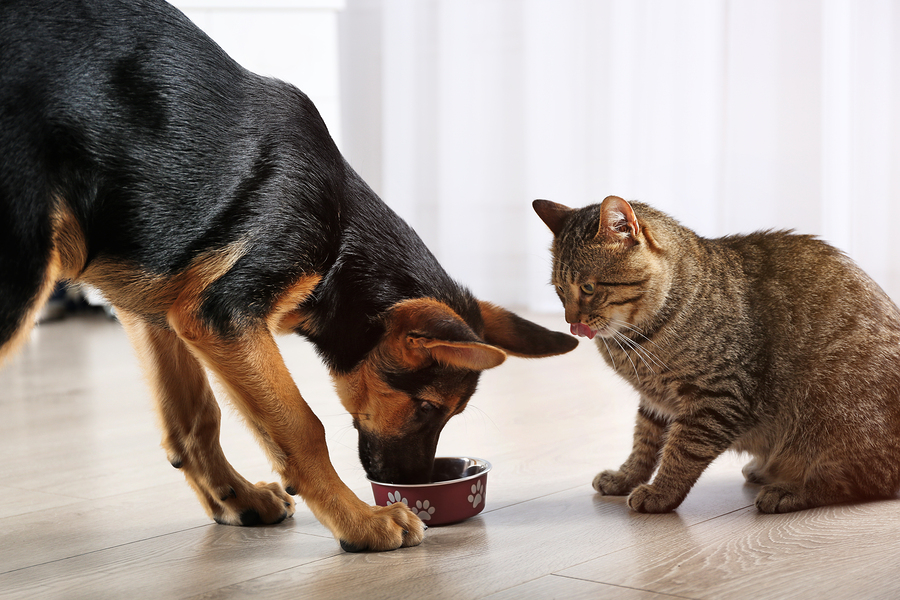
This post may contain affiliate links. We are compensated for referring customers to our affiliate partners.
Chances are, your dog has probably eaten things much stranger than cat food, but allowing your dog to continue to snack on cat food can have consequences.
Why Do Dogs Love Cat Food So Much?
It is pretty clear that dogs have no problem snacking on the cat food whenever they can. In fact, some dogs seem to love cat food so much that their owners have begun using it as a form of treat to reward them with. So what is the secret to this love of cat food? At first glance, it would look as if dog and cat food are basically the same thing. They both come as dry kibble that is similar in shape, color, texture, and smell. However, these two types of pet food are actually quite different when you take a look at the ingredients inside.
Unlike dogs, cats are obligate carnivores which means that their food is extremely rich in protein and will have a different flavor than dog food. It is likely that your dog’s love of cat food comes down to this delicious high protein flavor that their own dog food does not contain.
What Is The Big Deal If My Dog Loves Cat Food?
As mentioned previously, cats are obligate carnivores. Obligate carnivores are those who are ‘meat eaters by necessity’. Basically, cats cannot survive without meat in their diet and will have a much higher need for protein than other carnivores.
Dogs are not obligate carnivores, but are actually omnivorous. This means that though dogs do greatly enjoy and benefit from eating meat, they also need to have plant material within their diet in order to survive. In addition, being omnivorous means they do not need to consume such a high level of protein either.
So cat food has a little extra protein, what’s the big deal?
It isn’t just a little extra protein, cat food is extremely protein dense which a dog’s stomach is not prepared for. Thus eating cat food can cause upset stomach and a variety of digestion issues for your loyal companion. This can be especially hard on a dog’s liver and kidneys due to the large increase of iron from the extra protein.
Not only does cat food have a high level of protein, but it also has a much higher level of fat which can cause excessive weight gain in dogs and increase the risk of your dog developing a case of pancreatitis.
3 Tips For Keeping Your Dog Out Of The Cat’s Food
1. Take the cat’s food to a separate room
The most effective way to keep your dog from eating cat food is to simply move the cat’s dish to another room that your dog won’t be able to get to during meal time. If your dog happens to be small in size, setting up a gate that your cat can easily jump over should do the trick. However, if your dog is much larger in size, it may be better to have a small flap installed in the door. This way your cat will continue to have free access to their food, but your dog won’t.
2. Elevate your cat’s bowl
If you do not have another room that can be used for the cat’s food, you may want to try putting the cat’s dish on a higher surface like a counter or bookshelf. Cats typically have no problems when it comes to jumping on to high places, but your dog will.
3. Invest in a cat crate
If your dog and cat are around the same size, this most likely won’t work. However, if possible, try to find a cat crate that is small enough for your cat to get into and eat in, but leaves no room for your dog to.
4. Don’t leave out the food
If there is cat food that is just left out throughout the day, then your dog has a lot of opportunities to sneak around and get a couple bites in. Try to feed your cat at very specific times during the day and put away any food they were unable to finish eating.
What If My Dog Refuses To Eat Their Own Dog Food?
Then you may have stumbled on the bigger issue. While cat food does a great job of attracting dogs all on its own, they may actually be eating it because of issues with the dry dog food you have been feeding them this whole time. Here are a few things you can try to get them to eat their dry dog food in addition to keeping them away from the cat’s food:
1. Feed your dog at specific times for only 30 minutes at a time
If your dog believes it could have other food options, it will be less inclined to eat what you feed them. Be consistent with your feeding times and your dog will learn not to simply ‘wait and see’ when it comes to meal time.
2. Try switching dog food brands
It could also be possible that there is something about the current brand of dog food that just doesn’t sit right with your dog. While this could mean you need a more expensive brand, it could also mean that their old dog food was making them feel unwell.
3. Exercise with your dog before meal times
Nothing gets your dog’s mouth-watering like a little exercise. Try to go on a walk before meal time to use up some excess energy and get them hungry for their dry food.
4. Feed your dog in a separate room
This one tends to be more valuable for young dogs and puppies that are too easily distracted by other humans, cats, toys, and etc. to eat properly. Find a separate space or encourage others to leave the dog alone during feeding times.
